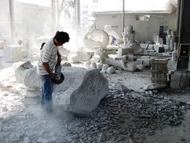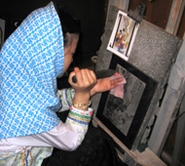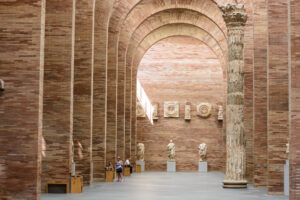
Home » Journal Articles » Travel » Sculptors Travel to China Jan/Feb 2008
Five lucky NWSSA members had a wonderful time in Southeast China last year. Jim Tobin, Leon White, Karl Hufbauer, Arliss Newcomb and Joanne Duby will tell you a little something about it. Jim’s Chinese stone sculpting and bronze casting business associate, Della Li, was the sixth member of the crew. Della, who is fluent in English and Mandarin, guided our group through the intricacies and wonders of her China. To learn more about Della’s China sculpting tours you may email her at: della_xue@yahoo.com.cn

Leon’s Log
November 2
After yesterday’s 15 hour flight and a 5 ½ hour bus ride today, we finally arrived at the Mei Cheng jade and stone carving factory where Jim has been having his sculptures carved for the past 5 years. The factory, a simple courtyard, is a small family run business with an amazingly large output.
Jim had a number of finished pieces there waiting for his final OK, and he also brought more models for them to work on. Arliss, Joanne and Karl also brought models to be made into sculptures. Although I hadn’t planned on it, the whole process looked like so much fun that I went through the jade pile, found a brown speckled stone, got a large leaf with interesting curves from a tree out back and am having the jade carved into this leaf form with a frog hidden under one of the folds to remember our experience here.
November 3
Della, our wonderful guide, took us to a roadside eatery for breakfast. We had noodles and delicious long sweet bread. It was enjoyable eating with the locals. Then back to the factory to work on our designs. I took a break and strolled along the riverbank by the factory. Women were washing their clothes in the river that was lined with houseboats. China is a contrast between ancient and modern.
November 5

Breakfast was buffet style in a large room with tables that sat ten. The room was filled with engineers from many countries there to work on the Three Gorge Dam, an enormous undertaking with far-reaching consequences. A lot of three thousand year old history will be five hundred feet below water forever, not to mention the million and a half people who will need to be relocated. (Ed’s note: to learn more, Google the Three Gorge Dam Project.)
We returned to Shanghai on the bullet-train, silent on magnetic tracks. The Shanghai train station was modern and enormous. Lugging our luggage through the subway to the city, convinced us all to pack lighter. More exploring around Shanghai led us to the main avenue that looked like Las Vegas with lights and billboards.
November 7
At the bronze foundry, we parked next to GIANT bronzes outside of the shop. Twelve feet high at least! I didn’t want to get out of the car and show them my tiny walnut size birds I brought to have cast, but they were very nice about it. Going back outside, we took photos of rice being dried on cement pads. This was a quaint housing area and still doing things the old fashioned way.
After a 2 ½ hr. flight to Xiamen, two employees from the granite factory that we were going to visit met us and drove us the three-hour drive to our hotel.
November 8

As we pulled into the courtyard of the granite factory, “AWE” was not enough of a description. Throughout the stone-yard there were huge carved Buddha’s, Chinese figures, animals, pillars, etc. In the large tin-covered work area workers were carving with minimal tools. They mostly used hammer drills and angle grinders with 10-12 inch blades, even for the smallest of details.
After touring the yard, we went into the office to rest and have tea. Some of our group showed the reps their websites to get quotes for reproducing sculptures on a larger scale.
November 9
Today we went to a park along the ocean. At the entrance stood two of the 30-40 feet carved pillars that we saw being made at the factory. In the park I counted 160 life-size granite statues and none of them were the same! All along the coast were mounds of granite boulders flowing like lava. We could see where the granite had been harvested in spots with large chunks obviously removed.
We walked back to the hotel along the sea wall stopping in various shops along the way. In some of the shops, artists were sitting on small stools while tapping with a chisel point on granite, making detailed images. They would look at a photograph of a person, animal, or landscape and then they would make thousands of little dots with the point chisel until it looked like the photograph.
The afternoon and evening were spent getting heavenly hour-long $5 foot massages and then going to a Karaoke Bar where we laughed ourselves silly.
November 11

We headed for the Botanical Gardens — a beautiful large garden where we found a lovely tea house. The tables and chairs were carved from natural tree roots. The lacquered tables had been carved into miniature village scenes with compartments for making the tea and to set the teapot and cups on.
Then back to the hotel to pick up our luggage then off to the airport for our flight back to Shanghai. This trip was more of an adventure safari than a vacation. Everyday was fantastic with so many wonderful highlights. Amazing!
Karl on Granite Sculpting in Today’s China
China’s economic boom, which began some two decades ago, has become so broad and deep that even the ancient granite-shaping crafts and arts of Fujian Province have been completely transformed. In fact, entrepreneurs there—urged on by regional and national officials—have industrialized all branches of granite fabrication in the province’s Huian County. They have done so by capitalizing on the abundance of white granite there, the proximity of the major seaport of Xiamen and the survival of some long-standing international ties from the days before Mao.
These entrepreneurs have established at least a hundred large granite factories. Some of these factories focus on producing dimensional granite for construction, landscaping, and cemeteries; others, on manufacturing decorative and utilitarian pieces for a myriad of end-uses; and a few, on sculpting bigger pieces for private and public venues.
It was one of the larger of these granite-sculpting factories in Huian County that our group visited. We’d learned of the Fujian Huafengsheng Stone Carving Co., Ltd., [HFS] from Vancouver sculptor George Pratt the prior summer. His long email reports to Arliss about its endeavors were so interesting that we wanted to witness how the job of sculpting large hard stones had been industrialized and gauge for ourselves the craftsmanship and design qualities of the resulting works. Founded in 1995, HFS moved five years ago to the town of Shanxia’s new industrial park. Since then, the firm’s workspace has grown to 4 huge sheds with motorized hoists; its workforce of stone shapers, to some 200 men; and its jam-packed display areas to at least two acres.

Our first responses upon arriving at HFS’s entry gate were gasps of astonishment. Despite having a cumulative sculpting experience of roughly 75 years, we were amazed by the abundance and variety of work along the display aisles leading away from the gate.
The firm’s output depends neither on large investment in sophisticated equipment nor on assembly-line techniques. Rather it relies on the typical worker’s industriousness, his proficiency with one or another set of basic tools and techniques, and his ability, while working mainly on his own; to use his specialty for readying the marked-up piece he has been assigned for its ensuing stage of development.
The marking is done by a few master carvers guiding those engaged in the roughing out, detailing, and final surfacing. The pace of work is steady—averaging ten to twelve hours a day for twenty-eight days a month. The use of safety equipment minimal. The wages, though modest, are often better than in the workers’ distant hometowns and villages in China’s interior.
While HFS’s typical worker does not think of himself as an artist, he does participate in the creation of an array of work that our group of visiting sculptors regarded as art. We saw hundreds of sculptures with dimensions between 5 and 30 feet. They included traditional Chinese, classical western, moderns (including a rare Mao), animals, body parts, abstracts, garden fountains, bridges, and more. Refreshingly, most of the pieces were finished without any high polishing and many had integral bases. The designs were often striking, and the craftsmanship in the detailing and finishing, generally enviable. Just as usually happens when stoners are visiting a large symposium or show, we all came across pieces that we wish we’d carved or, at least, imagined doing so.
I found myself wondering, “How will we American sculptors compete in the decades ahead?” Three general answers come to mind. First and most important, we must strive to develop designs that, in fresh ways, stretch the envelope. Second, we must continue honing, and enriching our craft skills. And third, we must do a better job of informing potential patrons about the ways in which our individual backgrounds, ideas, and labor resulted in the unique pieces that we want them to buy.

Dream Trip To China With Arliss
Picture five people walking thru a large shopping market place, asking every few minutes, “Della how much does this cost?” Our wonderful guide never lost her cheerful smile and was always there ready to help. We had a wild taxi ride to a hotel near her apartment so we could get an early start the next morning to catch our bus to Hangzhou.
Della said she had a very special restaurant picked out for our breakfast. Another wild taxi ride brought us to the golden Arches of McDonalds. We all had a good laugh at Della’s joke. It was then south to Hangzhou through farm land with lots of new, attractive housing complexes.
Mr. Yu and his son-in-law picked us up and drove us an hour and a half west to his Jade carving workshop. Jim has been working with Mr. Yu and his carving crew for several years. Each of us had made models and taken pictures of the pieces we wanted to have carved. Choosing the stone we wanted, Della and the Master Carver then looked over each design, making notes on our photos.
After spending 3 days with Mr. Yu, we were driven back to Hangzhou with a stop at a silk factory. It was like stepping back in time. The machinery was run by overhead belts and pulleys using thin wooden folding punch cards to set the pattern for each loom. Karl told us these wooden punch cards were invented by Joseph Jacquard in 1801, and revolutionized weaving all over the world.
Back in Hangzhou in the early afternoon, we stayed in a 5 star hotel just across the street from a beautiful man-made lake in the center of the city. Marco Polo wrote, “Hangzhou is the most beautiful city in China.” It still lives up to Marco’s description, having miles of walking paths through lovely gardens with stone statuary everywhere.
At a late lunch by the lake, we choose from over 20 types of tea. The price, about $5, included an abundant, Mandarin smorgasbord.
Next morning Jim and Della took us for another walk along the lake, then a quick taxi ride into the city for shopping. Ever helpful Della was kept busy translating and bargaining for us. Leon wore the clothes of an Emperor (at least for a few minutes) and Jim had a clay bust of himself made by a young artist in another few minutes. It was a good likeness too.

Of course I mustn’t forget to tell you about the food. I quickly learned to eat with chopsticks, and so never missed a meal. Food was very good excepting the fish eyes and chicken feet. All the seafood was fantastic, as were the eggplant dishes and huge variety of vegetables. Lucky for me we did a LOT of walking, I lost fifteen lbs!
After flying to the busy, tropical city of Xiaman, we were picked up and driven to where George Pratt had his big fish carved. We enjoyed touring “George’s factory” after seeing all the photos he had sent to Camp B.
Hopping on behind motor-scooter taxies, we rode to a fantastic garden at the far end of town with 160 near life size sculptures of the Heroes of the Mist who saved the city from a war lord hundreds of years ago. Even the garbage cans in the park were carved from granite.
It was here that we took a 40 min ferry ride around the island of Gu Lang Yu. Just a quarter mile off-shore, the island was the enclave of foreign traders during the 19th century. Now it is a big tourist attraction with no cars allowed.
Back in Shanghai, we all had a big farewell dinner because JoAnne, Jim and Karl had to fly back home the next day. Lucky Leon and I were able to stay for another 5 days of exploration with Della.
China has left me with a feeling of more adventure in my future. We must make the most of our life as opportunities arise.
Joanne Gets The Last Word
As a quick postscript, the trip was amazing. I’m still blown away by what I saw. I’m so glad that Jim let us share this experience. Without him or Della we would’ve been like blind mice and not seen half the sights we saw. Most of the fun was being with rock crazy people like me in a land where sculpture is everywhere. We had the time of our lives and I can’t wait to go back.







We need some kind of descriptive text here.